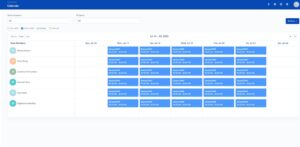How to Make Productivity Metrics Work for Your Business Goals?
5 min read
How do I make productivity metrics work for my business?
This is a question most business owners and managers ask themselves every time they face a productivity issue.
Let’s face it – some businesses are more productive than others. They are not just more productive, they also manage to manage to do a lot more value-adding things like team-building activities.
How do they do it?
The secret is to use the right metrics to measure team and individual productivity.
Leaders and managers within an organization use productivity metrics to measure business performance and guide decision-making. They help organizations make better decisions about their goals, priorities, and strategies.
If your company has never measured its productivity before, this blog post will give you all the information you need to get started today. It will also show you how to use productivity metrics to achieve your business goals.
Let’s dive into the topic of productivity metrics:
Table of Contents
The Importance of Measuring Productivity
It’s essential to measure productivity because it helps you understand what your employees are doing and producing during their workday. You can then see if they’re working hard enough and whether they’re spending time on the right tasks.
Here are a few more reasons why you need to start measuring productivity:
- It helps determine which areas of your business require more attention. For example, if sales are down, you might want to focus on the activities of your sales team. If your customers are waiting too long in the queue to get support, you would want to drill down into what your support agents are doing.
- It helps identify bottlenecks in your workflow. A bottleneck occurs when one task takes longer than expected. For instance, ads created by your team may be stuck with the client for weeks for approval, delaying campaigns.
- It shows you where your employees spend most of their time. This can help you plan projects and tasks better, decide staffing levels, and identify areas for improvement.
- It helps you track progress towards your business goals. By monitoring your productivity over time, you can see if your team and processes are improving and moving you towards your targets.
- It helps you learn from past mistakes. By knowing how long it took your employees to complete specific tasks, you can easily spot patterns and trends. These insights can help you improve processes, allocate resources, and create new products.
What Are Productivity Metrics?
A productivity metric is a measurement of a specific aspect of your business performance.
For example, your sales team may be measuring a bunch of metrics like new sales, year-on-year growth, and monthly targets. By tacking these metrics, you get to know whether your sales team is on track to meet its sales target for the month/quarter/year.
While sales metrics are the most widely used metrics, every function or job role should have a productivity metric assigned to it.
But measuring productivity just for the sake of measuring it will not help. You need to relate the productivity metrics to your business goals. That’s how you can tell if your team is doing everything it can to achieve your business goals.
Ways to Calculate Productivity
Calculating an employee’s productivity is pretty straightforward:
Productivity = Output / Input
In most cases, input is the time employee spent to produce the output.
For example, if a content writer takes a week to write a blog post, her productivity is one post per week.
You can use this metric, time taken to write a blog post, to measure the productivity of a content writer. Easy, isn’t it?
But there’s one more thing you need to take worry about – is this the best metric you can use for this job or task?
One way to do that is to consider the impact the job or task has on the business. For example, a well-written blog post on your website can drive hundreds of visitors through SEO and social sharing. How will it impact your sales?
Will you want your writer to produce two average blog posts in a week or one high-quality post that can drive an additional thousand visitors a month?
If you prefer quality, then you better measure the blog post’s performance over the next 3-6 months. This would be a much better metric to measure the writer’s productivity.
Understood?
Great! Now let’s look at the six simple steps you need to take to set up the right metrics for your team:
Great! Now let’s look at the six simple steps you need to take to set up the right metrics for your team:
Determine what you want to measure
Before calculating productivity, you need to figure out precisely what you want to measure. Do you want to measure output or impact? Or do you want to measure both? Do you want to focus on individual employees or the team as a whole?
Select a time frame to measure
Once you have a clear idea of what you want to measure, you need to decide which time frame makes sense. Do you want to calculate productivity for a single workday, a week, a month, or even longer?
Measure each employee’s output over the selected time frame
Next, you’ll need to identify what each employee produces. If you’re measuring productivity based on results, you’ll want to track every task completed during the period. If you want to measure impact, you will need to decide how to measure that.
Determine an input figure
Most often you will use time – hours/days/week – as the input in the productivity formula.
Divide the output by the input
Divide the output figure by the input figure to determine a productivity ratio. For example, it could be two blog posts per week or 1000 extra visitors per blog post.
What Are the Issues with Common Productivity Metrics?
There are two main issues with productivity metrics. First, they can’t tell you everything you need to know about your business. Second, they don’t always reflect reality.
Productivity Metrics Can’t Tell You Everything About Your Business
The first issue with productivity metrics is that they can’t give you a complete picture of your business. For example, let’s say you run an ecommerce business selling clothing. You might assume that sales figures alone could help you determine which styles of shirts are most popular among your customers. After all, if your customers prefer blue shirts over red ones, maybe you should stock more blue shirts.
While sales data can show you which colors are most popular, it won’t reveal any information about the profitability of your merchandise. That means although you sell more blue shirts than red ones, you may not be making a profit because you’ve sold low-margin goods.
Productivity Metrics Don’t Always Reflect Reality
Another problem with productivity metrics is that sometimes they don’t accurately reflect reality. For example, let’s say you have 20 SEO professionals working who work 40 hours-a-week on client projects.
Let’s say you calculate their productivity based on the number of backlinks secured and hours worked. Some employees will get way more links per hour of work compared to others. You may think they are the most productive.
But are they?
What if the most productive ones are getting low value backlinks that do not make an impact on the client’s website?
This situation isn’t uncommon. Many businesses operate under similar conditions; they have several resources but few productive workers.
You can avoid this scenario by using another approach to measuring productivity. Instead of calculating productivity based on tasks completed, use impact on business.
Employee Productivity Metrics Examples You Can Use
There are many performance metrics managers and owners can use. Here are a few examples of employee productivity metrics you can use to make informed decisions about your business:
Time Accounting
Many businesses track time employees spend at work and take that as a measure of productivity. After all, if an employee is working actively for the time he is supposed to, he must be producing something worthwhile. This is known as “time accounting”.
Time accounting measures how much time each worker spends performing tasks related to their job duties. While it’s the easiest metric to track, it’s also the least useful.
Tasks Completed vs. Time Taken
The most common metric used to track employee productivity is tasks completed or output produced in a given time period.
To calculate this metric, you need two things – output produced and time taken to produce it. This is the standard productivity metric used for most industrial jobs. It’s the oldest measure developed using time and motion study.
It can be used to measure productivity even in modern services businesses like outsourcing companies. But it’s not the best option for digital businesses such as marketing agencies or software developers.
Performance Ratios
A second way to measure productivity is through ratios. A performance ratio compares the level of output from one worker to that of other workers in the same organization. In other words, it tells you whether one worker produces more output than others do.
One common performance ratio is the “performance index” (PI). The PI shows how many units of output are produced for every hour worked. It also reveals how well each individual performs relative to their peers. For instance, if you have a remote-based team, you can track their productivity by comparing the PIs of each member.
If John has a PI of 0.5, he produces half as much output as his colleagues do . Conversely, Mary has a PI of 2.0, so she produces twice as much output as her peers.
Revenue-per-Employee
The last type of metric that measures employee productivity is revenue-per-employee. This figure indicates how much money each employee brings in for the company. Revenue-per-employee is especially helpful when comparing different companies within the same industry.
It’s a popular productivity metrics for services companies like marketing agencies and outsourcing companies. It’s also a standard way for comparing companies in the SaaS industry.
If a company makes $1M and has 10 employees, the revenue per employee is $100K. If a competitor brings in $1.2M for the same number of employees, then it’s making $120K per employee. Clearly the second company’s employees are 20% more productive compared to the first one.
To use this metric effectively, you need to quantify every activity or task in terms of its impact on sales. Then you will have an objective way top drill down and see which employees/roles are contributing more and which ones are lagging behind.
How to Benchmark Your Productivity Metrics?
Benchmarking is important to compare your team’s productivity with others. It’s not good enough to know that your content writers can produce two blog posts a month. You also want to know if your employees than your competitor’s employees.
The best way to benchmark is to find comparable metrics for each function or job type in your business.
Benchmarking Productivity of Sales Team
It’s easy to measure and benchmark productivity of sales team in any business. Measuring sales team’s productivity is easy – just divide the total sales in the year by the number of people in your sales team. This gives you the aggregate sales productivity.
Then create a list of your top 3 competitors and get their annual sales. Then go to LinkedIn and search for people working in their sales team. Most professionals are active on LinkedIn, so it’s easy to find out how many salespeople a company has. Finally, divide the annual sales by the number of employees in the company to get sales productivity for each of your competitors.
Now you have some benchmarking data to compare your team’s performance.
An easier way to find benchmarking data is to search industry publications and websites for relevant data.
Benchmarking Productivity of Customer Service Employees
Customer service is one of the most important functions in a business. With customers becoming more demanding, it’s critical to provide the best possible service to your customers. But how do you know if your customer service team is doing the best it can?
There are several customer service metrics you should measure:
Number of complaints received and resolved per month
- Percentage of complaints resolved within the target time frame
- Average time taken to resolve a complaint
- Percentage of complaints resolved during the first call or interaction
Here is an excellent guide to customer service metrics.
You can also find benchmarks for these metrics by Googling. There are several companies that publish annual reports about customer service, including benchmarks for productivity metrics.
Conclusion
And that’s it! Productivity measurements are vital because they allow you to identify areas where you could improve. Using the ideas in this blog post, you can easily benchmark your productivity metrics and ensure that you’re meeting your goals.
Lest we forget, employee time-tracking is also crucial for measuring productivity. It allows you to track employee hours spent on various tasks and time spent completing each task. A time tracking software such as HiveDesk gives you accurate time data for calculating your team’s productivity.
At HiveDesk, we believe that our users deserve an intuitive, easy-to-use remote time tracking software. Our tool gives you visibility into important aspects of your business operations, including employee time tracking, screenshots, and task tracking.
Start your free trial today and start improving your team’s productivity.


